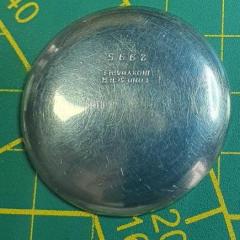Lots of watch stems mixed
-
Recently Browsing
- No registered users viewing this page.
-
Topics
-
Posts
-
The numbers in the white bar are the average values over the last x seconds. You can set x in the menus. The row of +4s are the s/d of the last four measurement periods. This short history is useful if the traces are wavy. Yours are just too good (dead straight)! The angle of the traces (very slightly up to the right, i.e. rising with time) is a graphical representation of the +4s/d. The vertical separation of the two traces is a graphical representation of the beat error. In your case it's 0.0ms, so the two traces appear to be one.
-
One of the problems with a lot of the videos are they really don't know what they're doing. Typically at the end of the service the put the watch on the timing machine often waiting into the watches fully cased up. As opposed to checking the movement when it's running before it's all cased up. In other words if you're going to have a problem it's nice to bill the work on the dial side without them being there for instance. Then when it is placed on timing machine the only place it in one position they comment how wonderful the numbers look and that really isn't adequate. But typically on those YouTube channels no one notices all the other strange and bizarre things they are doing either.
-
I agree with what the others are saying - I got a set of these when I was starting out and have never managed to use them, and I do a lot of Seikos. The other catch is that a lot of them have a brass arbor, which means that the hook for the spring is too soft and will wear out after a few uses, making them doubly useless. My advice would be to save your money and put it towards a Bergeon generic set - pains me to say it, but it's the only real option, unless you get a used set of generic winders on something like eBay, but this can be a minefield, especially if you aren't 100% sure what you are looking at. I would recommend a half set, if you can afford it, or if you are building up a few at a time, then size 5, 6, 7 will cover a lot of the mens watches. As a side note, if you are doing Swiss and Japanese watches you will need right and left handed versions as the Swiss springs tend to have a right hand wind, and the Japanese tend to have a left handed wind (there are exceptions of course in each case). If in doubt, post a picture on here before you order and people will guide you.
-
Both ends of the Poljot 2612.1 hairspring were "secured" with some kind if crappy glue. They came loose when I was straightening the spring. I placed all parts on the balance cock and used liquid shellac (dissolved in a bit of alcohol) to attach them again. I found using liquid shellac works easier then heating the solid stuff. The job is already fiddly enough without the need for a heatsource as well, but you need to be patient as it takes a few days for the liquid shellac to fully harden.
-
Cuare’s reply covers the Chinese winder set and their capabilities very well. An alternative to getting calibre specific sets like these is to slowly build a set of quality Swiss winders. They are sold individually, so you could buy a Bergeon handle and the 2 correct diameter and wind direction winders you need now initially, and buy the other sizes as you need them over time. If you come across a movement you lack a winder for and feel you won’t likely use that size winder often, then just buy a replacement mainspring, because they come already wound and ready to be pressed into the barrel You can usually sidestep the need for having both left and right winders in each size by reversing the wind of the spring as follows - wind the spring into a slightly undersized winder, push it out into the correct size winder to suit your mainspring barrel (thereby reversing its direction), and finally press it out into the mainspring barrel. Best Regards, Mark
-








Recommended Posts
Join the conversation
You can post now and register later. If you have an account, sign in now to post with your account.
Note: Your post will require moderator approval before it will be visible.